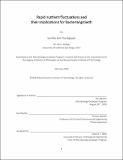| dc.contributor.advisor | Roman Stocker. | en_US |
| dc.contributor.author | Nguyen, Jennifer Kim Thu. | en_US |
| dc.contributor.other | Massachusetts Institute of Technology. Department of Biology. | en_US |
| dc.date.accessioned | 2021-02-19T20:48:01Z | |
| dc.date.available | 2021-02-19T20:48:01Z | |
| dc.date.copyright | 2020 | en_US |
| dc.date.issued | 2020 | en_US |
| dc.identifier.uri | https://hdl.handle.net/1721.1/129902 | |
| dc.description | Thesis: Ph. D. to the Microbiology Graduate Program, Massachusetts Institute of Technology, Department of Biology, February, 2020 | en_US |
| dc.description | Cataloged from student-submitted PDF of thesis. | en_US |
| dc.description | Includes bibliographical references. | en_US |
| dc.description.abstract | Bacteria, like all lifeforms, rely on resource acquisition for growth, and the tight coupling between bacterial growth physiology and nutrient availability has long been observed. When nutrient environments shift on timescales of hours, days or seasons, bacteria adapt to a physiological steady state characteristic of the new environment. However, the microscopic heterogeneity inherent of bacterial habitats implies that nutrient concentrations often fluctuate on timescales of seconds or minutes, timescales too rapid for bacteria to reach the steady state corresponding to the instantaneous environment. Despite this, steady-state growth is expansively used as a model to understand bacterial physiology, even in dynamic environments. In this Thesis, I experimentally demonstrate that bacterial growth in rapidly fluctuating environments cannot be predicted from steady-state growth models. Using a custom microfluidic device coupled with single-cell microscopy and image analysis, I quantified the growth physiology of thousands of individual E. coli cells experiencing either (1) periodic nutrient fluctuations on timescales ranging from 30 seconds to 60 minutes or (2) steady environments of equal average nutrient concentration. Growth rate in fluctuating environments was 16-50% smaller than in comparable steady environments, corresponding to a 10²- to 10⁸-fold loss in daily biomass production. However, cells grown in fluctuating environments had a growth advantage in the minutes after a nutrient shift over cells grown in steady environments. Cell size also displayed deviations from steady-state trends, with a particular fluctuating timescale producing cell sizes 54% larger than expected. These significant deviations from steady-state predictions highlight the importance of nutrient timescale and challenges our classical understanding of bacterial growth. | en_US |
| dc.description.statementofresponsibility | by Jennifer Kim Thu Nguyen. | en_US |
| dc.format.extent | 156 pages | en_US |
| dc.language.iso | eng | en_US |
| dc.publisher | Massachusetts Institute of Technology | en_US |
| dc.rights | MIT theses may be protected by copyright. Please reuse MIT thesis content according to the MIT Libraries Permissions Policy, which is available through the URL provided. | en_US |
| dc.rights.uri | http://dspace.mit.edu/handle/1721.1/7582 | en_US |
| dc.subject | Biology. | en_US |
| dc.title | Rapid nutrient fluctuations and their implications for bacterial growth | en_US |
| dc.type | Thesis | en_US |
| dc.description.degree | Ph. D. to the Microbiology Graduate Program | en_US |
| dc.contributor.department | Massachusetts Institute of Technology. Department of Biology | en_US |
| dc.identifier.oclc | 1237149198 | en_US |
| dc.description.collection | Ph.D.totheMicrobiologyGraduateProgram Massachusetts Institute of Technology, Department of Biology | en_US |
| dspace.imported | 2021-02-19T20:47:31Z | en_US |
| mit.thesis.degree | Doctoral | en_US |
| mit.thesis.department | Bio | en_US |
